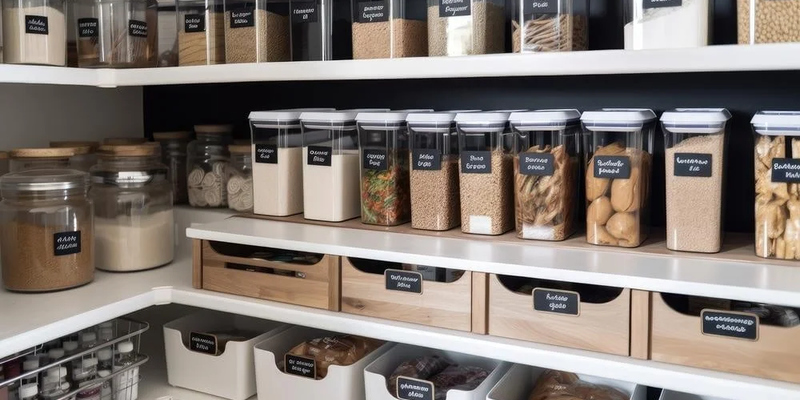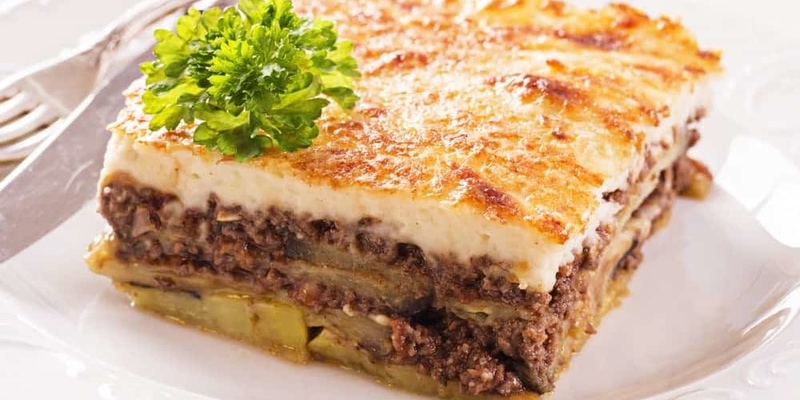Advertisement
Jan 01, 2000 By Sana

Do you feel frustrated when you make something in the kitchen and search for a specific ingredient for your dish but don't find it? You have to make a little effort in organizing your pantry.
An organized pantry can be a game-changer in the kitchen. When you open your pantry door, it looks neat, and you can easily access the ingredients you need for your recipe, saving a lot of time and money.
According to a recent survey, the average American household wastes about 31.9% of the food it buys, roughly $1,866 per year.
This post will give you ten ideas for organizing your pantry. Following these tips, you can transform your rough pantry into a smart one.
Why Does Pantry Organization Matters?

The organization of the pantry is not just about aesthetics; it is about having a powerful weapon in the kitchen and your everyday life. Let's explore why investing time in pantry organization is well worth the effort:
- Time-saver: No more having to rummage through stacked shelves. Locate what you are looking for within minutes.
- Reduces food waste: Record what you have so they do not elapse when you forget them.
- Simplifies meal planning: Creating a menu becomes easy when you can see your inventory at a glance.
- Encourages healthier eating: This is true because when healthy foods are offered and easily seen, people are more likely to grab them.
- Saves money: This saves a lot of your money.
- Reduces stress: Developing a system of organizing your pantry will help bring order and relieve stress in the kitchen.
- Maximizes space: Organization skills assist in using every square inch of available storage space.
- Improves food safety: Storing and rotating the items ensures they are fresh and do not spoil or become unfit for consumption.
- Inspires creativity: It is easier to be creative when you can see your ingredients and are encouraged to experiment with new ones.
- Streamlines grocery shopping: It is easy to know what needs to be restocked, and shopping trips will be efficient.
Addressing all these benefits will enhance the kitchen's functionality and ensure a better way of preparing and eating meals.
10 Brilliant Strategies for a Beautiful Pantry
Once you have determined the state of your pantry, the next step is to start organizing it. The following are ten brilliant tips that will assist you in organizing and designing a neat and efficient pantry for easy meal planning.
1. Declutter and Categorize
To start the pantry transformation:
- Empty the pantry and then group the items by category.
- Donate products that have not been used and throw away those products that have gone bad.
- Organize things like baking supplies, canned goods, snacks, etc. This process gives your pantry a fresh start and makes it easier to assess what is inside.
The National Association of Professional Organizers survey shows that 50% of homeowners regard the kitchen as the most cluttered area of the house. To overcome this statistic, the first thing you need to do is declutter.
2. Invest in Clear, Airtight Containers
Transfer dry goods like flour, sugar, pasta, and cereals into clear, airtight containers. This strategy keeps food fresher longer and allows you to easily see when you're running low. Opt for stackable containers to maximize vertical space.
Airtight storage can extend the shelf life of pantry staples by up to 6 months, reducing food waste significantly.
3. Label Everything
Use a label maker or chalkboard labels to mark each container and shelf. This will help everyone in the household know where items belong and make restocking easier. Don't forget to include expiration dates on labels for perishables.
A survey by the Container Store revealed that 83% of people feel more in control of their lives when their home is organized, and clear labeling is a key component of this.
4. Implement the FIFO (First In, First Out) Method
Arrange items so that older products are in front and newer ones in back. This helps prevent food waste by ensuring you use items before they expire. It's especially useful for canned goods and other non-perishables.
The USDA estimates that 30-40% of the food supply goes to waste. Implementing FIFO can significantly reduce your household's contribution to this statistic.
5. Use Vertical Space with Stackable Shelves
Add stackable shelves or risers to maximize your pantry's vertical space. This creates additional levels within existing shelves, allowing you to store more items without creating clutter.
A National Association of Home Builders study found that ample storage space is a top priority for 85% of home buyers. Utilizing vertical space helps meet this demand in any kitchen.
6. Install a Door-Mounted Organizer
Install a door-mounted organizer to utilize the often-overlooked space on the back of your pantry door. This is perfect for storing spices, condiments, or small snacks.
A survey by Kitchen Storage Solutions found that adding door storage can increase a pantry's usable space by up to 20%. This simple addition can dramatically improve your pantry's functionality without major renovations.
7. Group Similar Items Together

Organize your pantry into zones based on food types or meal categories. Keep baking supplies in one area, breakfast items in another, and snacks in a designated spot. This system makes it easier to find what you need and speeds up meal prep.
A study in the Journal of Consumer Research found that people are 40% more likely to choose healthy foods when grouped together and easily visible.
8. Create Designated Zones
Assign specific areas for different purposes a baking zone, a snack zone, a canned goods zone, etc. This makes items easier to find and simplifies the process of putting away groceries.
According to a National Kitchen and Bath Association report, 85% of homeowners find that designated zones in their kitchen improve their cooking efficiency and overall kitchen experience.
9. Utilize Turntables for Easy Access
Place lazy Susans or turntables in your pantry to make hard-to-reach corners more accessible. These are great for storing oils, vinegars, or small jars.
A study by the Organizing Institute found that using turntables can reduce the time spent searching for items by up to 50%, making meal prep more efficient and less frustrating.
10. Maintain a Pantry Inventory System
Keep a running list of what's in your pantry on a whiteboard or in a digital app. Update it as you use items or buy groceries. This helps prevent overbuying and ensures you always know what you have on hand.
A survey by the Food Marketing Institute found that households maintaining an inventory system reduce their grocery spending by an average of 20% annually.
Conclusion
By following these ten genius tips, you're well on your way to creating a pantry that's not just organized but truly functional. Remember, finding a system that works for you and your family is key.
Start small if you feel overwhelmed, even implementing just one or two of these ideas can make a big difference. As you organize, you'll likely find that you're wasting less food, saving money, and spending less time searching for ingredients.
This means more time for what really matters: enjoying delicious meals with your loved ones. Remember to revisit your pantry organization system every few months to make sure it's still working.
With a little effort and maintenance, your newly organized pantry will continue to be a source of calm and efficiency in your kitchen for years to come.
Frequently Asked Questions
Q: How often should I clean and reorganize my pantry?
Ans: Aim to deep clean and reorganize your pantry every 3-4 months and do a quick tidy-up weekly. This keeps things fresh and ensures your system stays functional.
Q: What's the best way to store bulk items in a small pantry?
Ans: Use airtight containers for bulk dry goods. Stack them vertically to save space. Label clearly and store less-used items on higher shelves.
Q: How can I make my pantry more kid-friendly?
Ans: For kids, place healthy snacks at eye level. Use clear containers so they can see the contents easily. Consider a small step stool for safe reaching.
-

Why Fusion Cuisine Is The Highlight Of 2024 Dining Trends
Sep 09, 2024
-

What Makes Botana Sauces And Chili Oils 2024’s Hottest Condiments?
Sep 09, 2024
-

10 Genius Tips to Organize Your Pantry for Hassle-Free Meal Prep
Jan 01, 2000
-

5 Tips for Making Creamy and Delicious Hot Chocolate
Aug 19, 2024
-

4 Simple Tricks to Avoid Soggy Pie Crusts Every Time
Aug 13, 2024
-

7 Secrets to Making the Perfect Greek Moussaka
Aug 19, 2024
-

7 Proven Techniques to Prevent Cheesecake Cracks for a Smooth Finish
Aug 13, 2024
-

The Ultimate Guide to Cooking Thai Green Curry at Home
Jan 01, 2000
-

5 Tricks to Add Creaminess to Your Dairy-Free Dishes
Aug 19, 2024
-

6 Smart Tips for Planning a Week of Healthy Meals
Jan 01, 2000
-

6 Secrets to Make Your Bread Rise Perfectly
Jan 01, 2000
-

5 Best Ways to Store Fresh Herbs and Keep Them Fresh Longer
Jan 01, 2000
-

Why Yuzu Is The New Citrus Star In Global Cuisine
Sep 09, 2024
-

Why Fancy Cookies Are The Affordable Treat Of The Year
Sep 09, 2024